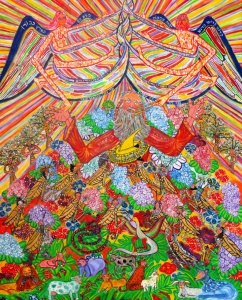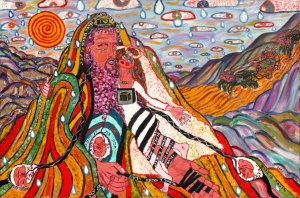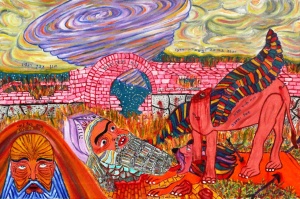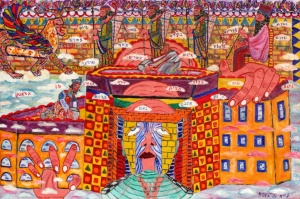Visualizing the Bible in a New Light
The rather large grasshoppers all have different human faces. The trees have human bodies with branches sprouting out of their heads. The animals in the Peaceable Kingdom garden seated at Isaiah’s feet are painted purple, pink, blue and red. Welcome to the visionary world of Nahum HaLevi’s Latter Prophets.The Color of Prophecy presents 15 oil paintings of all the Latter Prophets, each accompanied by a “unified artistic-literary, interpretive commentary.” This book is an ecstatic confrontation with the prophets of Israel through the dual mediums of art and text. The paintings were created over a three-year period ending in 2010 with the biblical analysis only written afterward. It is deeply significant that these images are not illustrations of HaLevi’s text but rather the images themselves reflect a primary commentary on the Biblical text. The author’s text often serves to explicate the dizzying images as well as explain the sacred text.

Visionary art emerges from within the artist’s imagination and psyche. As such it presents a deeply personal and private world, one that is foreign, strange and even frightening to the viewer. Here the subjects are particularly daunting, drawing on the just but brutal punishment of the Jewish people by God, the eventual destruction of our enemies and the final salvation of the Jewish people in the distant future. As is often the case when one encounters visionary art, one wonders about the nature of the artist; he must surely be a wild-eyed bohemian living in isolation much like the ascetic prophets he describes. So it is with considerable surprise that Nahum HaLevi is the pseudonym of Dr. Nathan C. Moskowitz, neurosurgeon, neuroscientist, inventor, author and, among many other credits, currently Assistant Professor of Neurosurgery at the Johns Hopkins Medical School. Wow.
The image of Isaiah’s Symphony in Salv-A-tion Major (2009, 64” x 48”) is initially striking because of the Seraphim. One of the two above him is holding a burning coal from the altar to the prophet’s lip to sear his iniquity away. Isaiah holds his hands up in grateful acceptance of Divine purification. He is blissed out in his red robe, proudly wearing his golden sundial to time his prophecies. But it is not only the angels that transport our prophet, no, he is in his glory as a conductor of a orchestra of God’s grateful creatures; the aforementioned grasshoppers (the diversity of their faces representing the nations of the world), many animals and trees included with more than a dozen multicolored clusters of tiny smiling and singing souls.

Where to go next in this feverish world? Perhaps Ezekiel’s Brain: Flotations and Rotations in the River of Time. The 12 resurrected skeletons are stunning, their life-force flowing into their bodies via a heavenly set of arteries. Yet the violent colors in the heavenly sphere are overwhelmingly cacophonous and chaotic, almost obscuring the vision rather than revealing it. In contrast The Bride of Hoseashtein: Betrothal and Exile (2007, 24″ x 36″) is clear and intelligible. God’s prophecy to Hosea invaded the inner sanctum of his personal life, ordering him to take a harlot as a wife and bear three children whose very names reflect the appalling distance between God and Israel. First born, Jezreel, signifies the imminent defeat of Israel in the Valley of Jezreel. Next born was the daughter Lo-Ruhamah, literally expressing God’s anger at the ‘not-pitied’ nation. Finally the son Lo Ami expressing God’s denial of His own people, Israel. We see them as three embryonic figures tethered to the union of Hosea and his wife. The sadness of this prophetic tale is overwhelming with tears falling down from the sky reflecting the very anguish that God Himself feels at the disloyal and wanton behavior of his chosen people.
The metaphor of the harlot wife Gomer representing Israel running after foreign gods and abandoning the Torah is almost too much to endure; Hosea himself bares his teeth in a grimace of disgust. And yet there is hope in the fact that the prophet is bound to his diminutive wife by the straps of his tefillin, wrapping her body and legs to his arm. The text on the arm strap proclaims the future reconciliation, “I will betroth you to Me forever; and I will betroth you to Me with righteousness, with justice, with kindness and with mercy; and I will betroth you to Me with fidelity and you will know Hashem” (Hosea 2: 21-22). Significantly the box of the arm tefillin is attached over his wife’s chest signifying the sincere change of heart on the part of the people of Israel.

Vengeance is sweet against our oppressors and the prophet Nahum seemed to specialize in this volatile attribute. Nahum: The Comfort of Vengeance (2007, 24” x 36”) depicts the destruction of Assyria and its capital, Nineveh in a starkly horrifying image. The prophet himself, in the lower left corner, is in a trance, his eyes rolled up and absorbed in the power of God’s words. Swirling above the entire scene and approaching the ruined and burning palace is a howling purple whirlwind; “Hashem–His path is in a storm and in a tempest” (Nahum 1:3) ready to finish for good all remnants of this evil power. The burning foreground is littered with symbols of Assyria’s former glory. The lion, once the pride of Assyrian prowess, lies shot through with arrows of the Lord. It looks in terror to the decapitated royal head of the famous winged guardian bull that used to “guard” the palace. Ironically emblazoned on its headdress is the prophecy “Nineveh is destroyed.” Nahum, the comforter, comforts Israel with the knowledge that God’s justice will finally prevail.

Finally after humiliating military defeat and harsh exile God is ready to relent and proclaims to the prophet Haggai, “It is the time for the Temple of Hashem to be rebuilt!” (Haggai 1:2). The painting Haggai’s Home Improvement (2007, 24” x 36”) conceives of the new Temple as literally emerging out of the prophet’s mind. As it grows and expands we see his hands attempt to shape the building, his left hand appearing over the roof on one side while his right hand punctuates the windows of the other. Perched on clouds floating by are snippets of his prophecy establishing the Divine authority by which the Jewish people dare to rebuild the House of the Lord. This vision takes place in the elaborate framework of the court of the Persian King Darius who allowed the Jews to return to their land. While we know that the Second Temple was actually built five years after Haggai’s prophecy, this vision seems to be taking place in a universe of clouds, further expressing the initially ethereal nature of the newly conceived Temple. One could well imagine that after years of defeat, suffering and exile, the notion of rebuilding seemed like a dream. It might even seem so when we will be commanded to prepare for the Third Temple sometime soon.
In distilling the often complex, mysterious and mind-bending language of the Hebrew prophets into 15 visual images the artist Nahum HaLevi has accomplished a remarkable feat. Prophecy, because of its proximity to the Divine, is by its very nature complex and enigmatic. HaLevi, by the fervor of his vision and urgency of his message, has made our prophets more accessible and understandable in his visionary paintings.